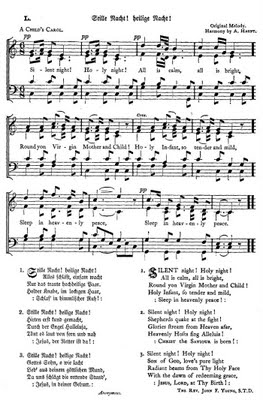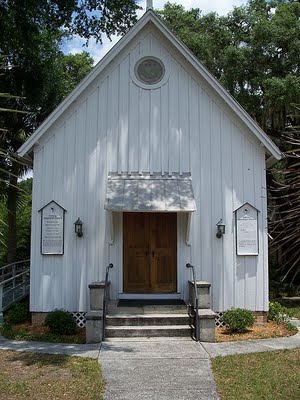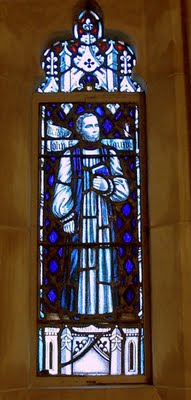I Knew Nothing About John Freeman Young
Last Sunday Ginny and I drove to Jacksonville Florida’s Old City Cemetery to visit the grave of John Freeman Young. Although I’d never even heard of the man before last week, I felt our visit made for an appropriate outing in this Christmas season.
Here’s a photo of Ginny at Young’s grave; notice the Christmas ornaments on the wreath:
Earlier in the week, while listening to a radio morning traffic report, I chanced to hear announcer Arthur Crofton say something about Young. That comment sparked my interest, so I did a bit of research and even read a biography of the man.
I’ve written two books about the history of my hometown so I was particularly surprised that I knew nothing about Young and his relationship with Christmas before.
In the late 1800s John Freeman Young served as the Episcopal Bishop of Florida. But that’s not his most notable accomplishment.
I think it odd that his biography tells about his labors as bishop but does not even mention the single aspect of his work that gained world-wide notoriety.
As an accomplished linguist proficient in several languages he translated a song from its original German into English. It’s a song you already know most of the words to—at least the first couple of verses. And I’ll bet that you and I will both be singing it within the next couple of days.
By translating the German-language "Stille Nacht! Heilige Nacht!" into the English as "Silent Night, Holy Night" John Young made a lasting Christmas gift to English-speaking people around the world. He published the song in 1859.
Here is a copy of the 1859 text of the first three verses—the ones you are likely to know—of his translation:

Yes, the man who translated Silent Night into English ministered right here in Jacksonville. And the wreaths placed on his grave in the Old City Cemetery each Christmas contain musical instruments as ornaments.
While most of us know those first three verses by heart—Silent Night is one of the most familiar hymns in the world—the last verses contain a deeper message in the song:
4. Silent Night, Holy Night
Here at last, healing light
From the heavenly kingdom sent,
Abundant grace for our intent.
Jesus, salvation for all.
Jesus, salvation for all.
5. Silent Night! Holy Night"
Sleeps the world in peace tonight.
God sends his Son to earth below
A Child from whom all blessings flow
Jesus, embraces mankind.
Jesus, embraces mankind.
6. Silent Night, Holy Night
Mindful of mankind's plight
The Lord in Heav'n on high decreed
From earthly woes we would be freed
Jesus, God's promise for peace.
Jesus, God's promise for peace.
Silent Night, a poem by Josheph Mohr, had been set to music and first sung on December 24, 1818, in St. Nicholas Church, Oberndorf, Austria. John Freeman Young heard the hymn and his English translation became one of the most popular and familiar of all English hymns.
A pdf copy of Bishop Young’s biography, Soldier And Servant, by Edgar Pennington can be read at http://www.archive.org/stream/johnfreemanyoung00penn#page/n3/mode/2up .
While Pennington’s 1939 biography contains much of interest to the Jacksonville history buff, it does not mention Young’s translation of Silent Night. In fact, while the biography dwells on the bishop’s church work, I felt disappointed that its diary excerpts contain little about his spiritual life.
Young, a native of Maine, began his ministry in Jacksonville in 1845, but moved to New York as the Civil War approached. Up north, he served at Trinity Church, Wall Street. It was while there he translated Silent Night among other hymns. After the war, in 1867, he returned to Jacksonville as bishop.
Tough. A yankee Episcopalian bishop in the war-torn South. One dilemma Young found was that unscrupulous yankee carpetbaggers had come to Jacksonville and taken advantage of recently freed slaves. These businessmen cheated the blacks out of real estate property and possessions. They even discouraged blacks from worship. One of the things Bishop Young did was to established several churches, such as St. Phillip’s, Jacksonville, as churches that welcomed blacks.
Bishop Young did that sort of thing all over the state. One of the more interesting portions of his diary tells how he spend three days and nights alone in a row boat, pushing it through shallow waters with a long pole, in order to visit congregations in a flooded area.
The war devastated Florida and the horrors of reconstruction left churches destitute.
Besides being a musician and linguist, Bishop Young, held an interest in architecture. He instituted the construction of a hallmark style of Florida church architecture known as Carpenter Gothic. Inexpensive local wood was used to form these distinctive church buildings, some of which survive to this day. Here is a photo of a typical example:

Bishop Young died of pneumonia in 1885. He was buried in Jacksonville’s Old City Cemetery. He is honored by a stained glass church window. The window gives no indication that he had anything to do with the famous hymn.

Nevertheless, I felt this Christmas season was an appropriate time to visit his grave:
Sleep in Heavenly peace, Bishop Young. Sleep in Heavenly peace.
Please, visit my website for more www.cowart.info and feel free to look over and buy one of my books www.bluefishbooks.info
posted by John Cowart @ 4:00 AM


2 Comments:
Dear John C,
Tears are falling easier at Christmas time, and this story really moved me to shed some more.
Silent night is the song above all Christmas songs.
Imagine that the translator, bishop young is buried in your home town. Imagine that his most famous achievement forgotten.
Even in Norway (we of course have our own Norwegian translation), Silent Night sung by Mahalia Jackson is the most played Christmas record.
We all remember story from ww1, when British and German soldiers exhausted beyond understanding in the muddy trenches, made seize fire and sung Silent Night/Stille Nacht together.
Well that would never happened had it not been for Bishop Young.
The history about how and why Silent Night was written by Austerian minister Mohr is well known to "children" of my age.
In those day, the age of the housewives, there were only one radio station and no TV. Children had to wait in the kitchen on Christmas Eve while the mother did the 5000 things necessary to a perfect Christmas celebration, (and yes it was always perfect, always, snow included).
As we sat there in the kitchen waiting for our bath and best clothes to be put on, the radio sent a program called "While we are waiting."
Never has a program had more exited and impatient listeners.
The same play was sent at least 10 years in a row, probably longer. The play about how Joseph Mohr had to write a new Christmas song, because the mice had ruined the church organ.
Stephan Zweig has also written that story in his famous "Sternstunden der Menschenkeit".
People never get tired neither of the song nor the Christmas memories from their childhood.
I thing you should make an article or preferably a book about the Silent Night influence and bishop Young in particular.
As I started; your story has moved me to tears.
Thank you for sharing.
From felisol
Really like those last verses--somehow we never get that far. Thanks for the history lesson!
PS--I am not dog food,yet.
Post a Comment
<< Home